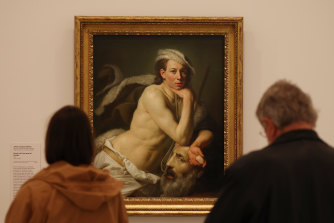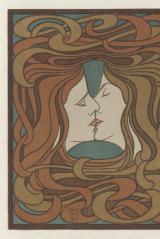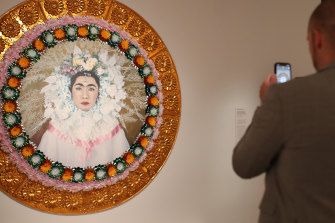Queer: Stories from the NGV Collection
NGV International, until August 21
“I would rather go to hell than to a homophobic heaven.” If he’d said nothing else, Desmond Tutu, the Anglican Archbishop of South Africa, could be forever remembered for this bold aphorism. The Bible recommends death for male homosexuals (Leviticus 20.13) and centuries of church dogma maintained the anathema; but against this authority Tutu declared that hatred of same-sex relations was ungodly.
Visitors admiring works at the National Gallery of Victoria’s exhibition QUEER.Credit:Getty
A picture by Sean Loughrey shows this brave leader laughing for joy after the release of Nelson Mandela in 1990 after 27 years in prison. The tiny image is one of 400 works in a gripping exhibition at the NGV called Queer: Stories from the NGV Collection. The premise of the show is not necessarily to foreground the work of LGBTQIA+ artists but to represent stories that the massive NGV holdings can tell about the historical experience of sexual diversity.
Peter Behrens, The kiss (Der Kuss), 1898.Credit:NGV
You’ll be surprised who turns up in the chronicles of the closet. A handsome proportion of European aristocracy had non-canonical leanings, to say nothing of artists. The point is not to out various household names, like Botticelli or Shakespeare. Rather, the exhibition presents a whole history of sexuality that artists grapple with today.
The keynote of the show is the visual extravagance that arose from protest. In European tradition, sexuality could be handled decorously, with aesthetic conventions hinting at lascivious content but still remaining comfortably tasteful. But to make space for themselves in a heteronormative world, queer activists required energetic solidarity. The result is a brazen out-there quality, a thrill of group exposure that makes sexuality shockingly visible.
This flamboyancy is seen throughout the show – from David McDiarmid to the high baroque of gay fashion – and the exhibitionism is justified. As the theorist David Halperin explains, the artistic tendency to objectification does no harm to those who are proud of it.
The exhibition honours figures like Napoleon who decriminalised homosexuality, just as it accuses others who persecuted sexual difference. But rather than brooding on the prejudices of the past, the show makes you curious about its paradoxes. An example is a section devoted to St Sebastian, a martyr who is held up as “patron saint of gays” thanks to being depicted in sensual poses while pierced by arrows.
The curator Angela Hesson relays the story from the biographer Giorgio Vasari “about the female congregants … who were so sexually ‘corrupted’ by Fra Bartolomeo’s nude depiction of the saint that the monks felt it necessary to remove it from the church in order to preserve propriety.”
More than 400 works take up the National Gallery of Victoria’s exhibition QUEER: Stories from the NGV Collection.Credit:Getty
Checking this source, I discovered that the record of the women’s excitement was obtained by the Brothers during confession. They must have risked breaking confidentiality to confer over the women’s arousal by “the comely and lewd” (leggiadra e lasciva) depiction of the languid body.
Patriarchy doesn’t enjoy women’s attraction to effeminate or vulnerable male bodies. As far back as you’d care to go, effeminate men were a beloved antidote to toxic masculinity, but then had to face its jealous revenge.
Another strength of the exhibition is its focus on intersections of gender, class and race. The exclusion from national archives is doubled when you add race or class to queerness; and many of the works directly tackle the museum for reflecting the bias of dominant culture.
Again, however, it’s more in the spirit of inquiry than redress; and consequently the works are often poetic in a lasting way. An example is Dianne Jones’ Woman in a black dress, where the First Peoples artist inserts her face in a formal Victorian portrait. The match is slightly awkward, which gives the work an uncanny air because the stolid pictorial convention was never conceived for a racial or gendered refreshment.
The exhibition comes with an excellent publication by the curators plus international and First Peoples scholars. The NGV has self-evidently loved the project of excavating the queer backdrop to its sterling monuments and showing them alongside their contemporary BIPOC critique.
A cultural guide to going out and loving your city. Sign up to our Culture Fix newsletter here.
Most Viewed in Culture
From our partners
Source: Read Full Article


